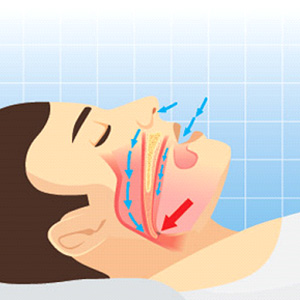Many conditions are being linked to the sleep disorder called sleep apnea. But what is sleep apnea anyway? It is a general term that describes a condition where a person stops and starts breathing during sleep. Episodes of apnea can last just a few seconds and can happen once or twice up to 20 or even 30 times a night. It’s estimated that 22 million Americans have sleep apnea and most cases are undiagnosed.
Sleep apnea can affect children and adults, and most cases are first noticed by parents or partners hearing the tell-tale gasp for air as a person comes out of an episode during sleep.
Types of Sleep Apnea
There are three types of sleep apnea: obstructive, central and complex sleep apnea.
Obstructive
Obstructive sleep apnea is the most common form affecting up to 80 percent of sleep apnea cases. With OSA, the throat muscles, tongue, tonsils, or soft palate relax and cover the airway, preventing breathing. Someone with obstructive sleep apnea usually snores as the soft tissues vibrate from the airflow of a person’s breath. Anyone can have OSA, but it tends to develop more frequently in people who sleep on their back, those who are overweight, and middle-aged men, although recent studies have shown the risk of developing OSA level out as we age.
Central
Central sleep apnea is less common than obstructive sleep apnea, but studies estimate up to 20 percent of apnea cases are related to central sleep apnea. Central sleep apnea, or CSA, is a neurological disorder where the brain “forgets” to tell the lungs to breathe. People with CSA usually have other serious illnesses including Parkinson’s disease, brain injuries or trauma to the brainstem, chronic heart failure, and kidney failure. Cases of central sleep apnea are also seen in people who use opiates. In some cases of central sleep apnea, a person will not stop breathing altogether but will have periods of very shallow breathing alternating with periods of very deep “over breathing,” called Cheyne-Stokes breathing. While a person who has obstructive sleep apnea probably doesn’t have central sleep apnea, the opposite is true for those with CSA. In fact, many cases of central sleep apnea aren’t diagnosed until a person exhibits symptoms of obstructive sleep apnea and goes in for testing. This is called complex or treatment-emergent sleep apnea. This form of sleep apnea (and many cases of central sleep apnea) is usually diagnosed when treatment for obstructive sleep apnea fails to keep the airway open during sleep.
Complex
According to a 2006 study done at the Mayo Clinic, 15% of the 223 sleep study participants exhibited symptoms of complex sleep apnea. General symptoms of sleep apnea may include daytime fatigue, insomnia, snoring, waking up with a gasp or startling yourself awake, waking with dry mouth, redness and other signs of irritation in your mouth and throat, and headache. If you regularly experience these symptoms, take our sleep survey, and tell your dentist or healthcare provider. There is no permanent cure for sleep apnea, but there are many forms of noninvasive treatment like CPAPs and appliances worn over the lower teeth available to help you can get a deep, restful sleep. At Go To Sleep Center, located in Phoenix and Scottsdale, we provide a quality & convenient solution for patients who suffer from snoring and sleep apnea by offering a dental device as a CPAP alternative.

